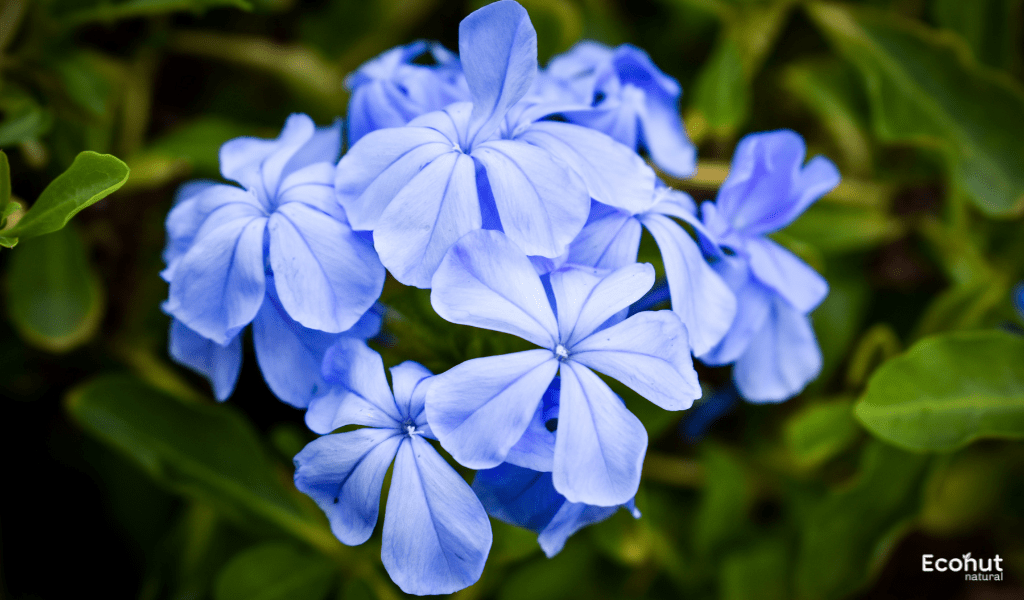Nila Chitrak (Plumbago Auriculata) . The plant’s roots bark, and aerial portions are utilized for their herbal medicinal qualities and include a variety of chemical components. In Ayurveda, it is used to cure a variety of conditions, including fever, headaches, toothaches, and excruciating physical pain.
Nila Chitrak in India, the plant is easily obtainable and frequently planted in gardens due to its vivid inflorescence. Many Ayurvedic treatments are prepared from the plant’s root and root bark.
Description
This plant’s leaves have a white coating below. The plant produces stunning blue flowers, and the summer is when it flowers. This shrub’s flowers include glandular hairs that release mucilage, a sticky substance that aids in trapping tiny insects. Fruits are divided into five pieces like capsules.
Botanical Name:
Plumbago Auriculata
Family:
Plumbaginaceae
Leaves:
The leaves exhibit a thin texture, a green color, and little gland spots. This plant’s leaves have a white coating below.
Flowers:
The sky blue blooms have tubes that are one inch long and open into five petals that are roughly one inch broad. The flowers resemble phlox blossoms and are produced in rounded terminal clusters that are 6 inches in diameter. All year round, with the exception of the coldest winter months, plumbago flowers.
Roots:
Long, thick, and woody, with a slightly wrinkled texture, dark brown or black hue, and a powerful, pungent smell and bitter taste, are the characteristics of Nila Chitrak roots.
Stems:
Nila Chitrak has semi-woody, flexible, and slender stems. They have a silky texture and a pale green or brown tint. The stems frequently sprawl or climb over neighboring plants, reaching a maximum length of ten feet.
Habitat:
Basically, this plant is indigenous to South Africa, where it is primarily found in the country’s tropical and subtropical zones. It is frequently observed near the eastern and southern capes. These days, it’s grown in England, China, Sri Lanka, and Southern Europe. This plant is grown as indoor and outdoor ornamentals in India.
Parts Used:
- Roots
- Leaves
Dosage:
- Powder – 1 -2 gm
Chemical Constituents
The main bioactive substance found in P. auriculata is plumbibagin. Numerous pharmacologically active substances, including phenols, alkaloids, saponins, flavonoids, steroids, proteins, and carbohydrates, are potentially hidden within the plant.
Sanskrit synonyms
Vahnisajnaka, Agni, Anala, Dahana, Pithi, Agnika, Jyothi, Nirdahana, Vahni, Sikhi, Vyala.
Other Language Names of Nila Chitrak (Plumbago Auriculata)
Thai name – Chittamuun
German name – Zahnkraut
English name – Cape Plumbago, Cape Leadwort, Blue Plumbago
Hindi name – Nila Chitrak
Tamil name – Neela Kodiveli
Sanskrit name – Krishna Chitraka
Chinese name – Ian-Zue-Hua
Scientific Classification
| Kingdom | Plantae |
| Clade | Tracheophytes |
| Clade | Angiosperms |
| Clade | Eudicots |
| Order | Caryophyllales |
| Family | Plumbaginaceae |
| Genus | Plumbago L. |
| Species | P. auriculata Lam. |
Nila Chitrak (Plumbago Auriculata) Uses
- Additionally useful for healing wounds and internal damage are roots.
- Additionally, roots work incredibly well as an analgesic to reduce severe pain and inflammation.
- To halt bleeding, external paste made of leaves and roots is applied to recently sustained wounds.
Nila Chitrak (Plumbago Auriculata) Benefits
Cures Piles:
This plant is often used to prevent and treat piles and hemorrhoids since it is a strong laxative. Chitrak’s strong laxative (Rechana) effect softens feces and makes them easier to evacuate from the intestines and the anus. It prevents anal fissure, bleeding, and the protrusion of a mass from the anus by lowering the pressure on the lower part of the intestines. Additionally, it strengthens the intestines and aids in colon cleansing.
Stimulates Digestive Function:
Prolonged health issues might cause excruciating discomfort due to a compromised digestive system. The extract from Plumbago zeylanica might improve appetite and stimulate the digestive system. It also helps in the battle against diarrhea. For people impacted by the status of the pile, it is the best course of action. Because of its special Charak formulation, it can help the anal blood circulation, which prevents piles and the anxiety that goes along with them, without using any harmful chemicals.
Weight Loss:
Nila Chitrak (Plumbago Auriculata) root extract’s high flavonoid content facilitates the body’s rapid weight loss. Rich in fiber and other minerals, chhatrak plays a crucial function in a person’s weight loss regimen by satisfying cravings and reducing overindulgence when eaten on a regular basis. The powder increases metabolism and aids in maintaining a healthy weight while reducing the body’s buildup of LDL, or low-density lipoproteins, or bad cholesterol.
Improves Heart Health:
This herb was utilized as medication in the past to guard against heart disease. This herb’s juices are fantastic at decreasing cholesterol, which both prevents heart disease and is a major cause of heart disease. Consuming Plumbago zeylanica on a daily basis will lead to a healthier lifestyle. Additionally, it can keep your heart healthier and prevent strokes and heart attacks. Diabetes and other high blood sugar conditions can potentially raise the risk of heart issues in conjunction with inflammation.
Nila Chitrak (Plumbago Auriculata) Side Effects
Digestive issues:
Possible adverse effects include irritability, cramping in the abdomen, and discomfort, particularly at high dosages.
Skin problems:
When Nila Chitrak is administered topically in its impure state, it can irritate, induce redness, and create itching in the skin.
Eye problems:
Nila Chitrak may occasionally result in dilated pupils.
Muscle problems:
Possible adverse effects include myotonia, or stiffness of the muscles, and hypotonia, or weakness.
Pregnancy:
Pregnant women should avoid using Nila Chitrak since it can cause bleeding and uterine contractions.
Also Read: Dill (Anethumn Sowa) – Uses & Health Benefits & Side Effects
Conclusion
Chitrak has been referenced as the ultimate cure for many health issues from ancient times in many ayurvedic texts. This amazing medicinal substance, which is categorized as a Rasayani Dravya, promotes physical and mental renewal. As a potent digestive herb, it helps with piles, indigestion, constipation, memory improvement, respiratory problems, inflammation relief, and overall body immunity and stamina.
FAQS
What are the benefits of Nila Chitrak (Plumbago Auriculata) plant?
It is applied to cause emesis. Warts can be effectively treated using powdered root. Snuffing powdered root relieves intense headaches. Root powder is used to lessen joint inflammation and is helpful for issues relating to the bones.
What are the side effects of Chitrak root?
Chitrak’s adverse effects include the following: When taken in large quantities, plubagin, which is present in the root extract of Plumbago zeylanica, causes irritation and colicky pain in the abdomen. Additional symptoms include dilated pupils, respiratory failure, myotonia, hypotonia, and skin redness and itching.
What is the use of Nila Chitrak?
In addition, it has antibacterial, febrifuge, detoxicant, and antihelminthic properties. The root is widely used in China and India to treat dysmenorrhea, rheumatoid arthritis, cancer, and contusions of the extremities. Plumbagin is an alkaloid found in the roots.

